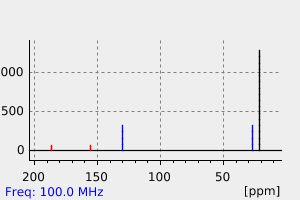2,5-diisopropyl-1,4-benzoquinone | 33685-58-4
中文名称
——
中文别名
——
英文名称
2,5-diisopropyl-1,4-benzoquinone
英文别名
2,5-diisopropyl-p-benzoquinone;2,5-di-isopropylcyclohexa-2,5-diene-1,4-dione;2,5-Diisopropyl-p-benzochinon;2,5-Cyclohexadiene-1,4-dione, 2,5-bis(1-methylethyl)-;2,5-di(propan-2-yl)cyclohexa-2,5-diene-1,4-dione
CAS
33685-58-4
化学式
C12H16O2
mdl
——
分子量
192.258
InChiKey
YVZNXZLRCMDYRS-UHFFFAOYSA-N
BEILSTEIN
——
EINECS
——
-
物化性质
-
计算性质
-
ADMET
-
安全信息
-
SDS
-
制备方法与用途
-
上下游信息
-
文献信息
-
表征谱图
-
同类化合物
-
相关功能分类
-
相关结构分类
物化性质
-
沸点:262.9±15.0 °C(Predicted)
-
密度:1.032±0.06 g/cm3(Predicted)
计算性质
-
辛醇/水分配系数(LogP):2.3
-
重原子数:14
-
可旋转键数:2
-
环数:1.0
-
sp3杂化的碳原子比例:0.5
-
拓扑面积:34.1
-
氢给体数:0
-
氢受体数:2
反应信息
-
作为反应物:描述:2,5-diisopropyl-1,4-benzoquinone 在 sodium hydroxide 作用下, 以 乙醇 、 水 为溶剂, 生成 3-(2,6-Dichloro-phenyl)-7-hydroxy-5,7-diisopropyl-7H-benzo[d]isoxazol-4-one参考文献:名称:The Reaction of Nitrile Oxide-Quinone Cycloadducts. III. Reinvestigation of the Base-Induced Isomerization of the 1 : 1 -C=C-Adducts of Aromatic Nitrile Oxides with 2,5- and 2,6-Dialkyl-Substitutedp-Benzoquinones摘要:通过X射线分析确定了2,5-二-叔丁基-p-苯醌与2,6-二氯苯腈氧化物的1,3-极性环加成物在碱引发异构化后的产物结构。1,3-极性环加成物中桥头位置的叔丁基团迁移至相邻的羰基碳原子。这种碱引发的重排在含有庞大取代基(即乙基、异丙基、叔丁基和苄基)的腈氧化物-醌环加成物在醇介质中发生。这一反应的驱动力被认为是由于从异噁唑啉衍生物到异噁唑融合p-喹啉衍生物的芳构化稳定作用。DOI:10.1246/bcsj.72.2549
-
作为产物:描述:2,5-diisopropylaniline 在 硫酸 、 sodium nitrite 作用下, 以 水 为溶剂, 反应 0.58h, 以41%的产率得到2,5-diisopropyl-1,4-benzoquinone参考文献:名称:The Reaction of Nitrile Oxide-Quinone Cycloadducts. III. Reinvestigation of the Base-Induced Isomerization of the 1 : 1 -C=C-Adducts of Aromatic Nitrile Oxides with 2,5- and 2,6-Dialkyl-Substitutedp-Benzoquinones摘要:通过X射线分析确定了2,5-二-叔丁基-p-苯醌与2,6-二氯苯腈氧化物的1,3-极性环加成物在碱引发异构化后的产物结构。1,3-极性环加成物中桥头位置的叔丁基团迁移至相邻的羰基碳原子。这种碱引发的重排在含有庞大取代基(即乙基、异丙基、叔丁基和苄基)的腈氧化物-醌环加成物在醇介质中发生。这一反应的驱动力被认为是由于从异噁唑啉衍生物到异噁唑融合p-喹啉衍生物的芳构化稳定作用。DOI:10.1246/bcsj.72.2549
文献信息
-
A New Selective Method for the Homolytic Alkylation and Carboxylation of Quinones by Monoesters of Oxalic Acid作者:Fausta Coppa、Francesca Fontana、Edoardo Lazzarini、Francesco MinisciDOI:10.1246/cl.1992.1299日期:1992.7Alkyl and alkoxycarbonyl radicals were generated by oxidative decarboxylation of oxalic acid monoesters by persulfate; they were then utilized for the selective substitution of quinones.
-
Quinone C–H Alkylations via Oxidative Radical Processes作者:Ryan Baxter、Akil Hamsath、Jordan GallowayDOI:10.1055/s-0037-1610005日期:2018.8context of selecting optimum radical precursors and initiators depending on quinone identity and functional groups present. A brief survey of radical additions to quinones is reported. Carboxylic acids, aldehydes, and unprotected amino acids are compared as alkyl radical precursors for the mono- or bis- C–H alkylation of several quinones. Two methods for radical initiation are discussed comparing inorganic作为特别主题“现代自由基方法及其在合成中的战略应用”的一部分发布 抽象的 报告了对醌中自由基的简要调查。将羧酸,醛和未保护的氨基酸作为烷基醌的前体进行了比较,以进行多个醌的单-或双-C H烷基化。讨论了两种引发自由基的方法,比较了无机过硫酸盐和Selectfluor作为化学计量的氧化剂。动力学分析表明,自由基引发速率的显着差异取决于自由基前体和氧化剂的特性。在根据醌特性和所存在的官能团选择最佳自由基前体和引发剂的背景下,讨论了有效生产烷基醌的合成策略。 报告了对醌中自由基的简要调查。将羧酸,醛和未保护的氨基酸作为烷基醌的前体进行了比较,以进行多个醌的单-或双-C H烷基化。讨论了两种引发自由基的方法,比较了无机过硫酸盐和Selectfluor作为化学计量的氧化剂。动力学分析表明,自由基引发速率的显着差异取决于自由基前体和氧化剂的特性。在根据醌特性和所存在的官能团选择最佳自由基前体和引发剂的
-
Cross-Linking and Sequence-Specific Alkylation of DNA by Aziridinylquinones. 3. Effects of Alkyl Substituents作者:Robert H. J. Hargreaves、C. Caroline O'Hare、John A. Hartley、David Ross、John ButlerDOI:10.1021/jm991007y日期:1999.6.1cytotoxicities and DNA cross-linking abilities of several alkyl-substituted diaziridinylquinones have been investigated. The cytotoxicities were determined in DT-diaphorase-rich (H460 and HT29) and -deficient (H596 and BE) cell lines. It was shown that the cytotoxicities in these cell lines correlated with the relative rates of reduction by the purified human enzyme and with the cross-linking efficiencies.
-
Steric Effects on the Cyclability of Benzoquinone-type Organic Cathode Active Materials for Rechargeable Batteries作者:Takato Yokoji、Yuki Kameyama、Shun Sakaida、Norihiko Maruyama、Masaharu Satoh、Hiroshi MatsubaraDOI:10.1246/cl.150836日期:2015.12.5Benzoquinone derivatives, which undergo reversible two-electron redox reactions, should afford high capacity as positive electrode materials for rechargeable batteries. Although some benzoquinones have been reported as cathode active materials, their low cycle-life performance is a drawback. We prepared benzoquinones bearing alkyl groups with various degrees of bulkiness to investigate the relationship between the steric effects of the substituents on the benzoquinone skeleton and the battery performance. The introduction of bulky substituents, especially a tert-butyl group, on the skeleton significantly improved the cyclability.
-
The stability of carboquone in aqueous solution. II. Kinetics and mechanisms of degradation of 2,5-bis(1-aziridinyl)-3,6-dimethyl-1,4-benzoquinone and 2,5-bis-(1-aziridinyl)-3,6-diisopropyl-1,4-benzoquinone in aqueous solution.作者:AKIRA KUSAI、SEIJI TANAKA、SEIGO UEDADOI:10.1248/cpb.30.2534日期:——The kinetics and mechanisms of the degradation of 2, 5-bis (1-aziridinyl)-3, 6-dimethyl-1, 4-benzoquinone (MEB) and 2, 5-bis (1-aziridinyl)-3, 6-diisopropyl-1, 4-benzoquinone (IPEB) were investigated and compared with those of 2, 5-bis (1-aziridinyl)-1, 4-benzoquinone (EB) investigated previously. The degradation of MEB and IPEB follows pseudo first-order kinetics in the same way as that of EB. The pH-rate profiles showed slopes of -1 on the acidic side and +1 on the basic side, as did that of EB. Thus, the degradation of MEB and IPEB is subject to specific acid-base catalysis. The apparent activation energies for MEB degradation at pH 4 and pH 11 were 16 and 24 kcal/mol, and those for IPEB degradation were 17 and 23 kcal/mol, respectively. In basic aqueous solution, MEB and IPEB are degraded to dihydroxybenzoquinones with monohydroxy-mono (1-aziridinyl) benzoquinones as intermediates in the same way as EB. On the other hand, in acidic aqueous solution, (2-hydroxyethylamino) benzoquinones are produced from MEB and IPEB, as in the case of EB, but they are further degraded to hydroxybenzoquinones. This was not practically observed in the case of EB. This phenomenon can be explained as follows : the alkyl groups at the 3 and 6 positions of benzoquinone increase the relative hydrolysis rate of 2-hydroxyethylamino groups derived from the hydrolytic cleavage of aziridine rings at the 2 and 5 positions of benzoquinone, making it comparable to the ring cleavage rate of aziridinyl groups.研究了 2,5-双(1-氮丙啶基)-3,6-二甲基-1,4-苯醌(MEB)和 2,5-双(1-氮丙啶基)-3,6-二异丙基-1,4-苯醌(IPEB)的降解动力学和机理,并与之前研究的 2,5-双(1-氮丙啶基)-1,4-苯醌(EB)的降解动力学和机理进行了比较。MEB 和 IPEB 的降解遵循与 EB 相同的伪一阶动力学。与 EB 一样,pH-速率曲线在酸性侧的斜率为-1,在碱性侧的斜率为+1。因此,MEB 和 IPEB 的降解受特定酸碱催化作用的影响。在 pH 值为 4 和 11 时,MEB 降解的表观活化能分别为 16 和 24 kcal/mol,IPEB 降解的表观活化能分别为 17 和 23 kcal/mol。在碱性水溶液中,MEB 和 IPEB 降解为二羟基苯醌,中间产物为单羟基-单(1-氮丙啶基)苯醌,降解方式与 EB 相同。另一方面,在酸性水溶液中,与 EB 的情况一样,MEB 和 IPEB 会生成(2-羟乙氨基)苯醌,但它们会进一步降解为羟基苯醌。而在 EB 的情况下,实际上并没有观察到这种现象。这种现象可以解释如下:苯醌 3 和 6 位上的烷基提高了苯醌 2 和 5 位上的氮丙啶环水解裂解产生的 2-羟乙氨基的相对水解速度,使其与氮丙啶基的裂环速度相当。
表征谱图
-
氢谱1HNMR
-
质谱MS
-
碳谱13CNMR
-
红外IR
-
拉曼Raman
-
峰位数据
-
峰位匹配
-
表征信息
同类化合物
(反式)-4-壬烯醛
(s)-2,3-二羟基丙酸甲酯
([1-(甲氧基甲基)-1H-1,2,4-三唑-5-基](苯基)甲酮)
(Z)-4-辛烯醛
(S)-氨基甲酸酯β-D-O-葡糖醛酸
(S)-3-(((2,2-二氟-1-羟基-7-(甲基磺酰基)-2,3-二氢-1H-茚满-4-基)氧基)-5-氟苄腈
(R)-氨基甲酸酯β-D-O-葡糖醛酸
(5,5-二甲基-2-(哌啶-2-基)环己烷-1,3-二酮)
(2,5-二氟苯基)-4-哌啶基-甲酮
龙胆苦苷
龙胆二糖甲乙酮氰醇(P)
龙胆二糖丙酮氰醇(P)
龙胆三糖
龙涎酮
齐罗硅酮
齐留通beta-D-葡糖苷酸
鼠李糖
黑芥子苷单钾盐
黑海棉酸钠盐
黑木金合欢素
黑曲霉三糖
黑介子苷
黄尿酸8-O-葡糖苷
麻西那霉素II
麦迪霉素
麦芽糖脎
麦芽糖基海藻糖
麦芽糖1-磷酸酯
麦芽糖
麦芽四糖醇
麦芽四糖
麦芽十糖
麦芽六糖
麦芽五糖水合物
麦芽五糖
麦芽五糖
麦芽五糖
麦芽三糖醇
麦芽三糖
麦芽三糖
麦芽三塘水合
麦芽七糖水合物
麦芽七糖
麦法朵
麦可酚酸-酰基-Β-D-葡糖苷酸
麦利查咪
麝香酮
鹤草酚
鸢尾酚酮 3-C-beta-D-吡喃葡萄糖苷
鸡矢藤苷







